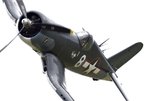drgondog
Major
Juha - I agree everything you said but wonder about the last comment. Fear of the unknown actual capability of a 'thing' like German airpower over the beaches could have paralyzed the Command Decision for May/June 1944. Had 8th AF not clearly defeated the LuftWaffe over Germany and experienced the same losses during and after Big Week with no pause because the P-47/P-38 combination been insufficient, then I believe that the Invasion Planners would have assigned a huge risk to the naval (and total logistic chain) assets from the LW.
We know from the actual history that USN/RN had little harrassment but the combination of resistance at Omaha and the following storm which destroyed the Mulberyy made the first week an 'uncertain' outcome as the events unfolded. So the effect of the storm was as close to a major problem as Allied high command thought it would be - what if LuftReich mostly intact, losses in acceptable 5% range during Feb?march And actaul airctaft losses at Oaschersleben, Leipzig, Augsburg, Schweinfurt and in the air had not occurred?
Any hesitation in March for a May/June assault left only July for a combination of tide and window of operational weather for the Invasion...
To me, that is the critical question for historians to ponder regarding the value of 8th BC as both the 'bait' and the strategic hammer to draw LuftFlotte Reich up - and the 8th/9th FC Mustang as the hunter to whittle them to point of near death from Big Week through May. The Mustang did Not win the war. We all get that - but IMO it was the single most important airpower asset added to the ETO. (and to MTO post May) The PTO would have managed, with higher daylight losses over Japan but the March 1945 tactics made even that long range daylight escort less critical.
We know from the actual history that USN/RN had little harrassment but the combination of resistance at Omaha and the following storm which destroyed the Mulberyy made the first week an 'uncertain' outcome as the events unfolded. So the effect of the storm was as close to a major problem as Allied high command thought it would be - what if LuftReich mostly intact, losses in acceptable 5% range during Feb?march And actaul airctaft losses at Oaschersleben, Leipzig, Augsburg, Schweinfurt and in the air had not occurred?
Any hesitation in March for a May/June assault left only July for a combination of tide and window of operational weather for the Invasion...
To me, that is the critical question for historians to ponder regarding the value of 8th BC as both the 'bait' and the strategic hammer to draw LuftFlotte Reich up - and the 8th/9th FC Mustang as the hunter to whittle them to point of near death from Big Week through May. The Mustang did Not win the war. We all get that - but IMO it was the single most important airpower asset added to the ETO. (and to MTO post May) The PTO would have managed, with higher daylight losses over Japan but the March 1945 tactics made even that long range daylight escort less critical.

